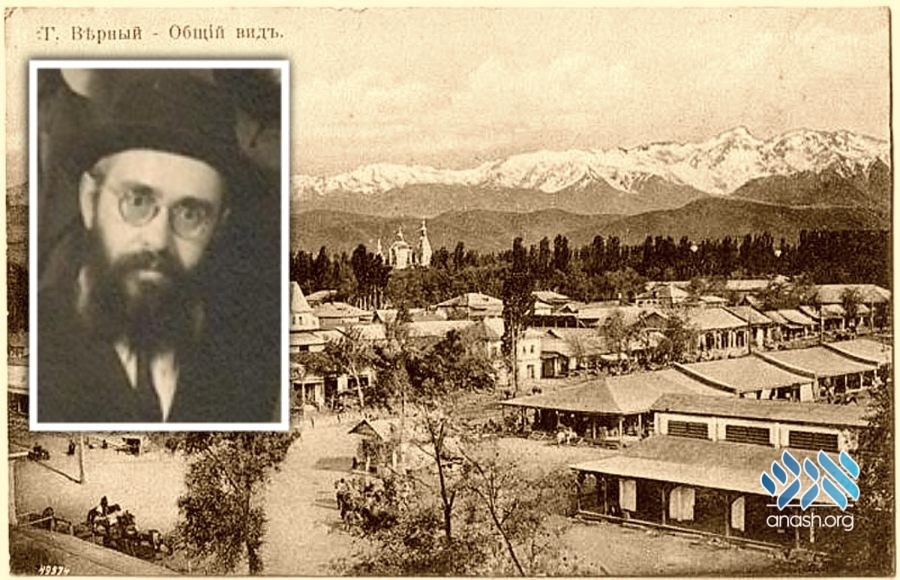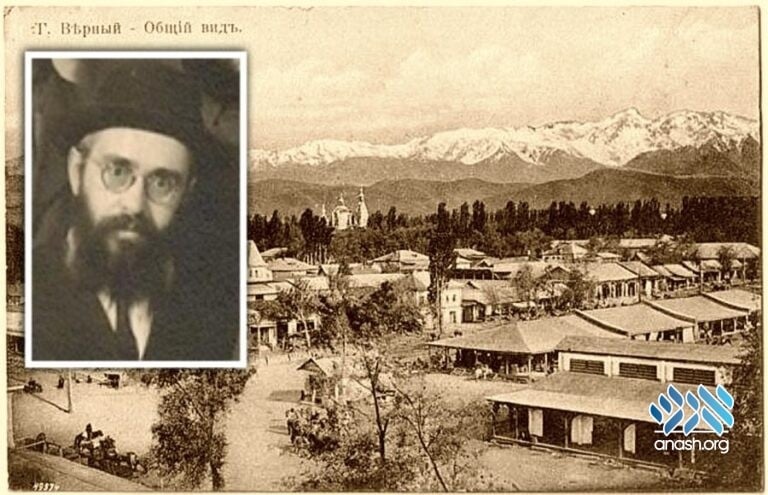כ״א אב ה׳תשפ״ד | August 24, 2024
Together in Alma Ata: From a Chossid’s Diary
In his diary, the chossid and mohel Reb Yaakov Yosef Raskin described how they secured Reb Levik’s release from exile, his time in Alma Ata, and the efforts to bury him respectfully. The diary has been translated to English by his grandson, R’ Benny Raskin.

In his diary, the chossid and mohel Reb Yaakov Yosef Raskin described how they secured Reb Levik’s release from exile, his time in Alma Ata, and the efforts to bury him respectfully. The diary has been translated to English by his grandson, R’ Benny Raskin.
By Reb Yaakov Yosef Raskin a”h, translated by R‘ Benny Raskin
I, along with my family escaped from Leningrad at the end of summer of 1941 on the very last train that left the city. The cursed Germans were systematically bombing all the bridges that connected Leningrad to the mainland, and we managed to escape on the last train crossing the one remaining bridge before it too was bombed.
We didn’t know where to go so we decided to continue traveling on the train until the last stop. We sat on this train with thousands of other refugees for about fifteen days, until we arrived in the city of Omsk in Siberia. The train traveled slowly, because of the constant danger of the bombs that were being dropped.
From Siberia we headed south and subsequently settled in Alma Ata, the capitol of Khazakhstan.
In the winter of 1944, in Alma Ata, my daughter, Tzivia, fell ill with typhoid fever and B”h she recovered well in the hospital. While she was in the hospital, she befriended a young Jewish lady, who was a judge in the civil court in Alma-Ata.
Understandably, Tzivia tried to bring her closer to Yiddishkeit and invited her to come from time to time to visit us for Shabbos meals and to eat gefilte fish and other Shabbos delicacies. She was originally frum, and had previously lived in Dnipropetrovsk, previously Yekaterinaslav. She also knew and heard about HaRav Levi Yitzchok and knew that he was incarcerated in exile for five years. By virtue of her position, she was well connected with the KGB.
At one point, she informed us that a decree was just issued from Moscow that prisoners who were sentenced to exile for up to five years will not be released until the war ends even though they have completed serving their entire five-year sentence.
She advised us that the only solution to obtain HaRav Levi Yitzchok’s release, was to arrange with the head office of the KGB to prepare for his release immediately as soon his release date is reached. This is necessary to be done before the decree arrives from Moscow that would extend his incarceration.
It was with Hashem’s kindness and divine providence that this judge approached us. She had many acquaintances in the local KGB office. This, however, involved many challenges. First, was the need to obtain a large sum of money for bribes to secure the cooperation of the highest officials in the hierarchy of the office. Thankfully, we worked very quickly and carefully, until we arranged with the head of the local KGB office to write a letter back-dated to a date preceding the date of the issuance of the decree from Moscow. All of this was a matter of Mesiras Nefesh because of the great fear of getting the authorities involved in this matter.
After we obtained all the documents that we needed for HaRav Levi Yitzchok’s release we sent two messengers to bring them to Che’ali. They were Reb Mendel Rabinowitz (who was disguised in a military uniform and a red kasket) and Esther, the daughter of Rabbi Eli Chaim Althaus. Esther stayed with HaRav Levi Yitzchok and Rebetzin Chanah over Pesach until the day after Pesach when she helped them pack up all their belongings and bring them to Alma Ata.
After Shavuot, HaRav Levi Yitzchok’s began to suffer greatly from the pain in his stomach, and even though he was able to join us on Shabbos for the minyan, it was evident that his condition was deteriorating each day. Here, I have to thank all my children who frequently helped with whatever was needed in the home of The Rebbe’s parents. In particular, during the last few weeks when HaRav Levi Yitzchok was confined to his bed, he found it difficult to put on tefillin himself. Every morning, I or one of my sons, Mendel, Sholom Ber, Dovid or Leibel, would help him put on his tefillin while in bed.
Parenthetically, in the matter of the head tefillin, there were challenges with the placement of the tefillin so it wouldn’t move, because he was very particular that the knot of the head tefillin was not placed in the hole of the nape, only on the protruding bone. This was difficult as his tefillin were large and we had to constantly adjust and straighten them to ensure that the tefillin were in the proper place.
About a month before his passing, I was called to do the Bris on a four-year-old boy. When I returned from the Bris, I went to visit HaRav Levi Yitzchok and told him that I was coming from the Bris of a four year old child. He struggled to get up and sat in his bed then grabbed my hand in his hand excitedly and said, “I am so envious of you that were able to perform this Mitzvah! You have accomplished a great feat!”
He then began to talk a lot about the significance of the number four, Hashem’s name is four letters and many other matters related to four… It’s a shame I never recorded his words at the time as he continued to speak passionately about this subject for about half an hour.
On the 20th of Av before sunset, his soul left this world and ascended to heaven in purity. (After some time passed the paraffin lamps were lit as there was no electricity.) In the morning, I was designated as the emissary from Anash to arrange his gravesite and I met with the local Chevra Kadisha. They went with me to search the entire cemetery for a suitable burial site.
Since I couldn’t find what I wanted, I asked the Chevra Kadisha to give us the free space near the entrance of the upper house and they agreed. I insisted that they give us six vacant plots to ensure that they remain vacant on all sides and must remain vacant. However, I heard that since then those plots were taken.
In the evening, they announced that whoever wished to handle the Holy Body should go to the Mikvah in the morning. In Alma Ata, there was no Mikvah but in Tastag (in the suburbs) there was a kind of round pool from rainwater which didn’t dry all summer and where we occasionally used it to Toivel. We all went there to Toivel. We also obtained planks (with difficulty) to make a bier and we carried the bier in our hands all the way from his home to his holy resting place, may his merit protect us and all of Israel.
About two weeks after HaRav Levi Yitzchok passed, I was caught on the street. I went to perform a Bris (but I didn’t actually do the Bris since the baby was yellow). As I was returning, I was approached by a KGB agent who accused me of stealing from a local children’s home. He insisted that I go with him to the nearby police station. Once there, he locked me up there saying that he would soon come back for me and told the policeman who worked there to watch me. I waited until the evening (for about five hours) until he returned with a car and took me to the main KGB office. There they held me all night, interrogated me, and demanded where I was from and I how I know Schneerson, and why my children are at home and not in the army, and other miscellaneous questions. They wouldn’t let me fall asleep all night and every minute the guard came up behind me, pushing my back and yelled at me to not fall asleep.
I already understood that the situation was terrible and I almost gave up that I would be able go home. Then at five o’clock in the morning, someone opened the door and looked at me, then a half an hour later told me to go home.
When I got home in the morning, I was afraid to be at home and didn’t sleep at home only at acquaintances. I decided to escape from Alma Ata but it was very difficult to get a ticket during war time. I didn’t know where to escape to so I decided to go directly to Moscow even though I didn’t know anyone there. All I knew was that there was someone from Anash named, Dovid Bravman, in Malachowka (near Moscow). We miraculously got tickets and left my house in the middle of the night of the 15th of Elul 5704 (1944) and travelled to Moscow. My daughter Tzivia accompanied me all the way there. (Some time later Tzivia was married to Dovid Bravman.)
The night before our trip, I went to visit Rebbetzin Chanah to bid her farewell and I told her everything that had happened. I told her that since I am traveling during Elul (in close proximity to Rosh HaShanah) and I don’t know where I will be, I asked her if she had a shofar that I could use. She willingly took out and gave me the Rebbe Maharash’s black shofar that she had with her. Eventually, at The Rebbe’s request in 5710 (1950), I returned it to The Rebbe and he would blow it on Rosh HaShanah in 770 for many years.


How did Rebbetzin Chana come to possess the Rebbe Maharash’s Shofar?
Very inspiring